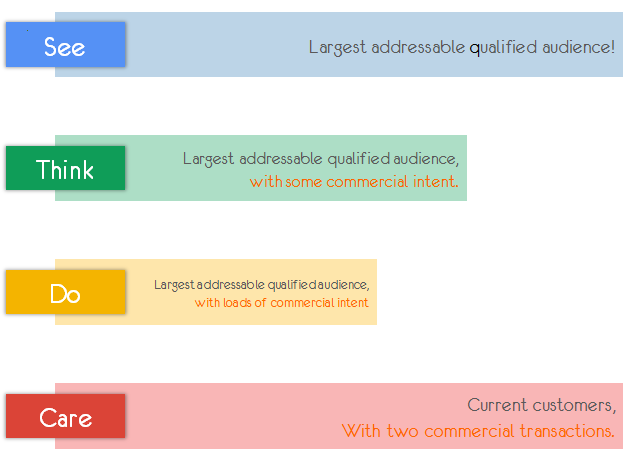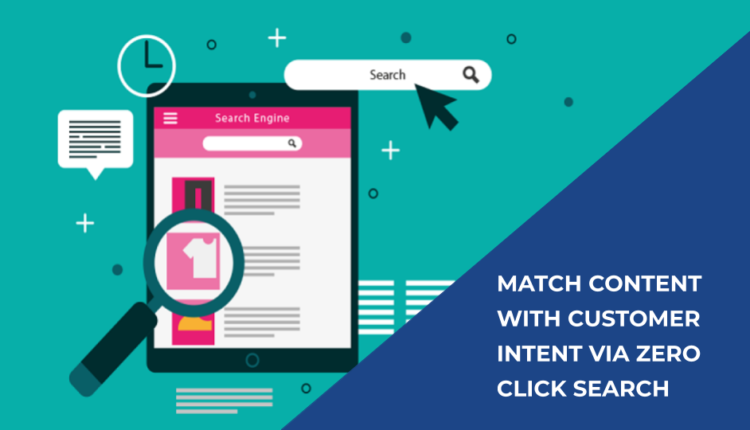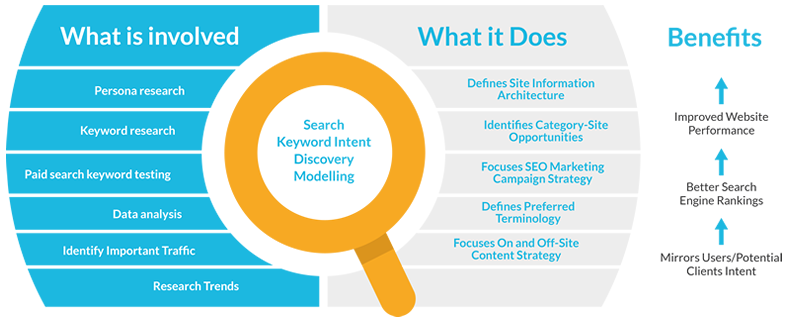Visitors or Customer intent is an important part of your content marketing strategy. When creating any kind of content or before you launch a marketing campaign, it is requisite to go through your target groups and find out what they are interested in and how they intend to find that information.
Customer intent may be also known as a buyer intent, with the main objective as an action at the beginning stage of a customer journey followed by a conversion.
Moreover, every customer or visitor differs in their intentions, and even a specific segment or target group can be broken down into smaller groups. Nevertheless, understanding why and what is potential customers looking for and how are they searching when they want to buy either product or service can simplify the marketing activities.
So today we will go beyond understanding the problems and needs of users and dive into their intentions. In other words, we are looking beyond the why, and into the how. Let’s dig in!
Intent Marketing vs. Interest Marketing
Customer intent represents a need you users want to be fulfilled. For example, let’s say you want to need to buy a new laptop and you search on google “Laptops”. From there, you can narrow it down based on what your exact requirements for the laptop are.
So, you may be using this laptop for entertainment and not for development. But you’re also not a gamer, so you don’t need a super-powerful computer. Then, let’s say you are also based in London, so you are interested in local shops and their offers.
All of these parameters construct your intent or need and are a crucial part of the decision-making process of every customer. And as marketers, we need to predict them and try to match our content with the customer intent.
Interest on the other hand is promoting content or goods to users without an intent. One example of interest marketing is the ads we see whenever we search for a website, even though we are not looking to buy something. The same goes for up-sales or product recommendations based on our behavior on an e-commerce site. However, in this article, we will focus on intent and intent marketing.
What is Customer Intent?
Customer intent may sound like a modern way of attracting sales that started when online selling became a thing. But in reality, it’s not that different than traditional marketing. Think about it. In the past, customers had to go to physical stores and choose from the several options available.
Maybe they came across a leaflet, or they saw a specific ad on a wall, or on TV. They would turn to friends, family, books, even store clerks for more information. In their research, they would ask questions and state their intents – Need a laptop, it has to be affordable, not too powerful, since it’s only for entertainment.
The only difference really is that times are changing, and you now go through the whole buying process from the comfort of your home, or on the way to work through your smartphone. Besides, the recommendations, tips, and advice are present on social networks and blogs, and websites.
So, in short, customer intent is nothing more than a need created from hundreds of parameters. And the key is to find as many of these parameters as possible.
Customer Intent vs User Search Intent
More often than not, inexperienced marketers will use customer intent and user search intent interchangeably. However, user search intent doesn’t always have a commercial value. This means that user search intent, be it voice search or “traditional” search, is not necessarily equal to customer search intent.
So it is important to understand the difference between the two terms if you are to conduct a proper content marketing strategy based on customer intent. There are four different types of user search intent in the beginning stage of the customer journey.
Informational intent
When you want to know about a topic, place, person, or thing. It has no commercial value or intent. For example “Who is the President of the US?” Or “Queen of Denmark”.
And because it has no commercial value, it will not translate into customer intent. In simple terms, users looking to know who the Queen is, will not be interested in buying a laptop from you.
Browsing Intent
When you need to find the address of a specific web page, like Twitter or Facebook. In that case, the search engine will indicate its official address. As you expect, this too is just a user search intent with no commercial value.
Commercial Intent
It is when you are looking for a product or service, although it does not precisely have to involve an electronic transaction. It is a stage of exploration before making the final decision. ” iPhone 12″ for example.
This is the equivalent to the basic customer intent we discussed earlier. It has commercial value, and it represents the stage where the user has identified a need and is collecting information.
Transactional Intent
This search intent represents the conversion phase. The search intents involve the purchase or contracting of a product or service, such as booking a hotel room, getting a plane ticket, or buying a new coffee maker on Amazon. ” Copenhagen Hotel Booking ” or “buy iPhone 12 ” would be two examples.
How Does Customer Intent Marketing work?
There are various tools, available for free to everyone, to help determine the intent. Google search for example is an excellent tool, as the search algorithms are already trying to predict your search intent. Or you can use social platforms such as Quora and Reddit, where you can see what users are searching for, how and get direct feedback from potential customers, as well.
Let’s go back to the laptop example. When users are entering the keywords “best laptops in 2020” into a search engine they are stating their basic intent. In this case, they still have no exact product in mind that they are looking for. However, they are aware that the tech industry will offer vast amounts of different laptops. On top of that, they rely on the fact that with just a few clicks, they can open a social network and find a post or a group of tech gurus from where they can get opinions and recommendations.
The goal for you and your business is to understand how your users might search for your content or offerings, and match them. So if your website sells or promotes laptops, your keyword cloud has to revolve around laptops, computers, and other terms like them.
But, don’t worry. While all of this sounds a bit complicated have narrowed it down to 4 main steps you need to follow to build the perfect strategy for intent marketing.
1. Keyword Analysis
Whatever your sector is, the Internet allows us to determine the search volume and competitiveness of individual search terms by using various techniques and tools. One option is keyword analysis. For example, Google Analytics allows you to track the performance of your keywords and how much traffic they generate.
Dedicated keyword analysis tools, such as Moz, ubersuggest.com, or Google AdWords will provide you with search volumes, search difficulty, and other key factors. More importantly, they will also provide you with variations and inspiration.
There are many such patterns and combinations of searches. They can be easily linked to content on your site as part of content creation to reflect your potential customer’s intent without knowing exactly what it is. Just analyze what the customer is searching for on Google and what they are asking on social networks. This data will form your keyword cloud and can then be linked to what you offer.
While doing keyword analysis, you can focus on 3 main intention types and purposes of the search queries. These are as follows:
1.1. Commercial and Highly Convergent Phrases
These are words that attract users into making an action also known as call-to-action word groups. In this group of words, we find phrases that provide high conversion and have a commercial value such as “buy now”, “coupon code”, “discount”, “opportunity”, “free shipping”.
1.2. Informational Word Groups
The words in this group are mostly focused on informing consumers. You can provide information to consumers and recycle content by using keywords such as “guide”, “why”, “history of…”, “what doe x mean”, “what is…”. Content recycling is especially easy and useful in Informational searches as all you need to do is create the base post once, and then keep it updated based on user searches and market trends.
1.3. Operational Word Groups
These words are included in commercial and informational keyword groups. But the difference is that with these words, by addressing the purchasing cycle of consumers, they can influence their product research process. Word groups such as “review”, “unboxing”, “comparison with…”, “top 10” can be given as examples of this.
2. Incorporating Keyword Analysis Into Intent Marketing
As understanding consumers’ search queries will help you learn their intentions and goals, you should also pay attention to this when doing keyword analysis. Specifically, you can pay attention to the following.
- Automatic word suggestions in Google search queries
- Search queries on the search box of your e-commerce site
- Search queries and automatic suggestion options in virtual marketplaces
- Google, location-oriented search query suggestions.
2.1. Organize Your Keywords to Increase Content Recycling
In order to increase your conversions, you need to consider the different phrases and intentions we mentioned above. Your informational keyword groups are ideal for blog content production. You can drive traffic organically with blog content and increase the value and ranking of your site in search engines by producing additional content for your site. Operational word groups can also be ideal for blog and video content, but they are especially effective in content recycling. Think of these recycled articles as cash cows. Not much attention goes into developing them, but they continuously bring value to your website.
Then, you can try and use your new and recycled content and interject in the purchasing process by directing them to your e-commerce site. Commercial and high conversion keyword groups are suitable for direct product pages and AdWords campaigns. This means that you rely on AdWords campaigns for paid traffic, but optimizing the product pages with the right keywords will provide long-term organic traffic.
2.2. Not all content is created equally
A more important factor than content marketing itself is how your content is built, not how often you publish it. This is because not all visitors who come to your site are in the same phase in the customer journey.
There are those who visit your website for the first time. Then, there are those who have already noticed something about you, but the website has not been attracting them enough to choose your products or services. Althewhile, you also have customers who already became regular visitors.
As you’re probably beginning to realize, trying to reach everyone with the same type of content will just not do it. So you need to direct different parts of your content on different intents – gather information, confirm decision-making parameters, convert.
2.3. Quality content over Quantity
It’s not just about whether you opt for infographics, plain text, or video. When creating content, you need to think about the target visitor. Who are they? What do they know about you? What might interest them? This is the only way you can offer them content that will convert them to e.g. buy your product or sign up for your newsletter.
Also, what is in the content is more important than its form. The format only gives the content a better structure and look. But it is qualitative content that converts users into becoming customers. This is the only way you can talk about doing content marketing. Otherwise, you are just a publisher.
Remember, content marketing is not about overtaking the competition as to who will have more content, but about making it easier for your potential customers to get to you. And if you adjust your content strategy, your competition can publish a hundred times more content than you do, and it will not affect your visitors.
3. Define your Content Marketing Funnel
Your content marketing strategy should be one of your main marketing funnels. Now, if you’re unfamiliar, a marketing funnel represents strategies you use to attract potential customers and turn them into loyal customers.
The traditional marketing funnel usually has three phases – See, Think, Do. So, in the first phase, you attract the user’s attention by matching their intent. They are people who first came in contact with you, also known as unique visitors.
In the second phase, you capture their interest with qualitative content. These are those who have already shown interest in your products or services but never converted. And third, there are paying customers. T

The content marketing funnel differs from the classic one in that it has an extra phase. So, the content marketing funnel follows the same template – see, think, do – but adds an extra step, care. This applies to recurring customers or customers with more than one transaction or action.
3.1. What type of content does the content marketing funnel include?
Once you have clarified the content funnel, it remains to be seen what type of content is suitable for a particular shopping phase.
Here is a list of what you could try to use in practice according to the 4 phases in the picture above:
Phase 1 – See
- Articles that attract attention or inspire
- Advertising on Google or social networks
- Specially designed landing pages
- Blog articles that give people the basics
- Videos of product/services or explanatory
- Infographics
- Viral content on social networks
Phase 2 – Think
- Articles that showcase your qualities, inform, or call-to-action
- Content on social networks
- Blogs (how to do something, instructions, etc.)
- E-books
- Case Studies
- Webinars
Phase 3 – Do
- Personalized articles based on shopping experience
- Email marketing
- Reviews
- Tailored case studies
- Special offers
- Service or product evaluations
Phase 4 – Care
- Articles that show that you value existing customers and want to improve
- Questionnaires
- Personalized email marketing to existing customers
- Blog articles that are only accessible to existing customers, who will find content that is more advanced than blogs that are normally public
- Posts and discussions on social networks
- Competitor analysis
- Special offers that are based only on the status of being your customers
This formula cannot be used on every website of course. Your success very much depends on who your customer is and how long your shopping cycle is. You need to tailor the content itself to your needs, but we believe that this article served as an inspiration for the way you should go if you want to see the results behind your content marketing.
4. Track, measure, adapt, repeat
Once you set up a strategy, remember that your work is not done. Your content marketing is an ongoing task, so once you start publishing Customer Intent matching content, you need to track its progress and adapt.
Using tools like Google Analytics you can easily find out which articles and pages perform best and try to adapt the rest of your content to better match that. Then, using any website analysis tools we are familiar with, monitor your keywords cloud, and keyword consistency.
Finally, remember that as the market changes, so is your users’ behavior. So keep an eye on them, location, active times, shopping and search habits, and so on. The more you keep on top of your user analysis, the better you understand their intents and the more precise and efficient your Intent marketing strategy will be.
Conclusion
The advantage of customer intent brings with it to master the wishes and purposes of internet users. As a matter of fact, in cases where the purpose of internet users is not analyzed well, users will turn to other websites, i.e your competitors, since their expectations will not be met throughout the page or site. In order for us to analyze the needs of users when searching, it is necessary to determine the purpose behind the search intention and to create a content marketing strategy, which is of great importance in digital marketing.
Moreover, Google is working on a number of new formats to show your potential customer in search results. It is important that you know how to use them to your advantage and connect them with its purpose. In addition to classic results, where there is a link, title, and description of your site, these include ratings, images, snippets, videos, paid results, local results, and more.
Subsequently, you need to create relevant content on the web, social network, and other channels that will interact with a potential customer or be searchable on Google.
If you have any additional questions regarding this topic don’t hesitate to contact us.


Comments are closed.